HI5019 Assessment 1: Strategic Information Systems for R.C.E. Limited
VerifiedAdded on 2021/06/02
|10
|2832
|52
Report
AI Summary
This report provides a comprehensive analysis of R.C.E. Limited's revenue cycle, focusing on its operational aspects and internal controls. The study delves into the responsibilities of different departments, including warehousing, transportation, and inventory management, highlighting their roles in the sales order and cash order processes. It identifies internal control weaknesses such as the lack of segregation of duties, non-standardized orders, and outdated credit policies. The report also explores potential fraud types, including employee and administrative fraud, and their implications. Furthermore, it offers recommendations for improving the internal control structure to mitigate risks and enhance the efficiency of the revenue cycle. The analysis underscores the importance of a robust internal control system for the company's financial health and operational success. The report concludes with a discussion of potential hazards related to the identified weaknesses and suggests strategies for their mitigation, emphasizing the need for standardized procedures and regular updates to policies.
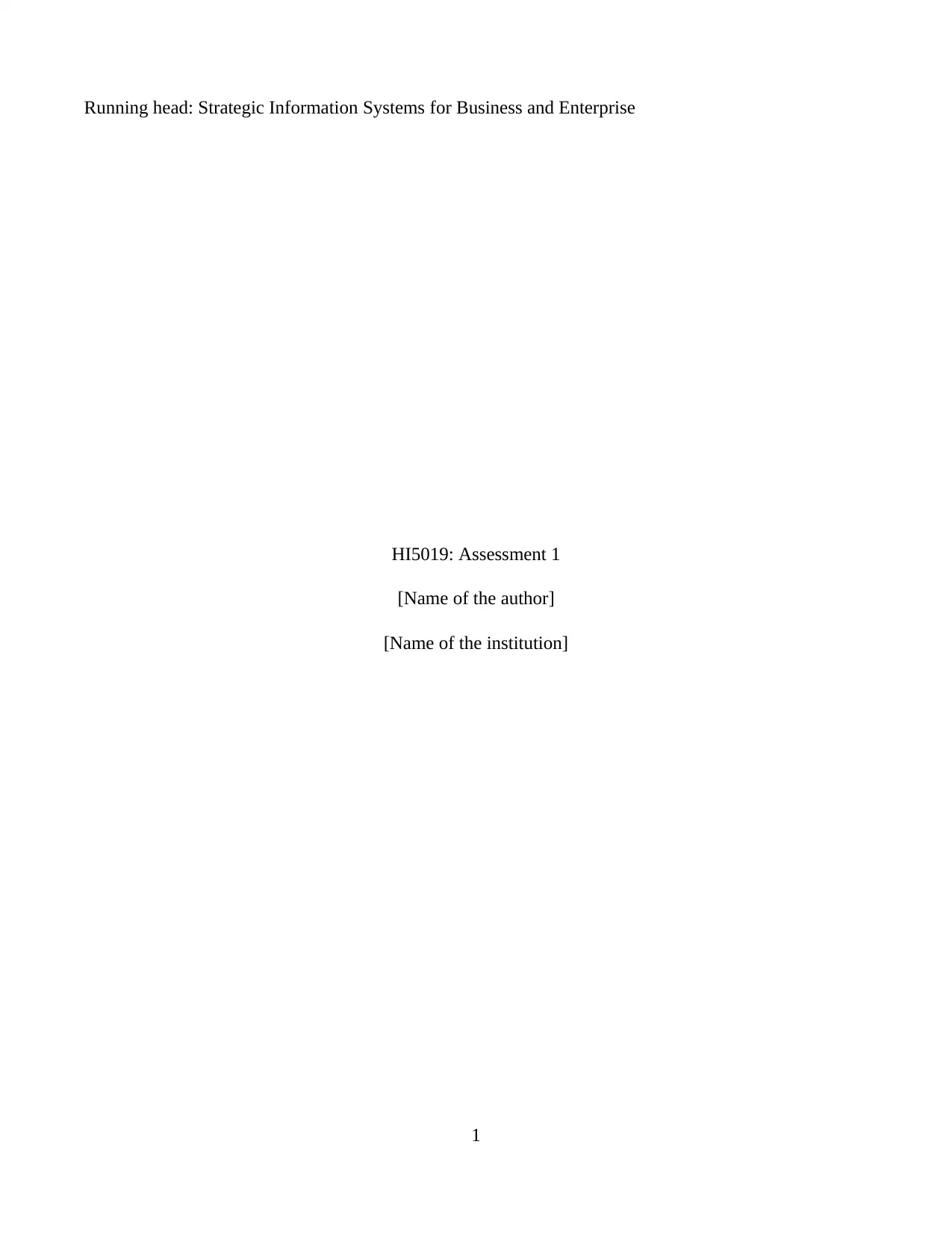
Running head: Strategic Information Systems for Business and Enterprise
HI5019: Assessment 1
[Name of the author]
[Name of the institution]
1
HI5019: Assessment 1
[Name of the author]
[Name of the institution]
1
Paraphrase This Document
Need a fresh take? Get an instant paraphrase of this document with our AI Paraphraser
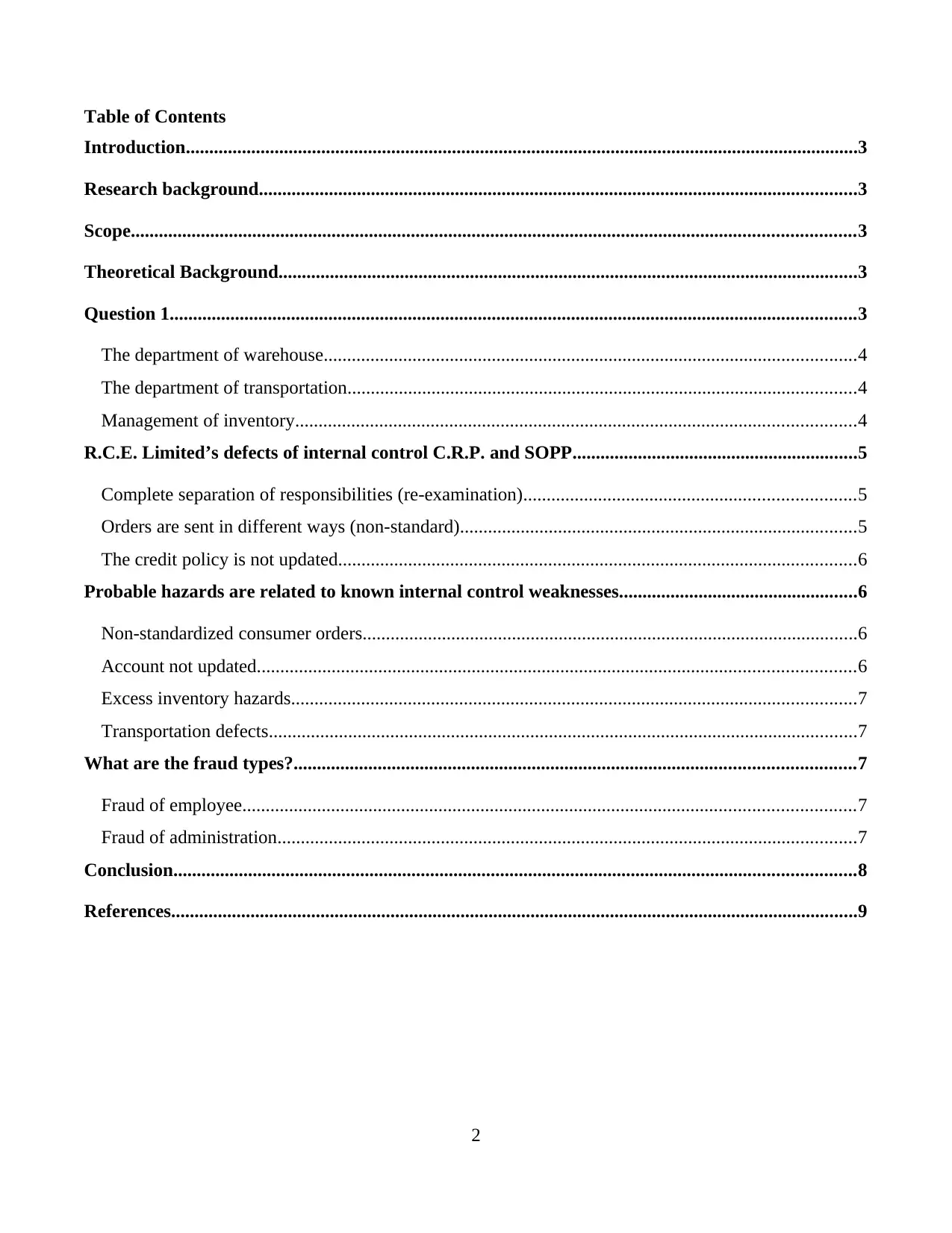
Table of Contents
Introduction................................................................................................................................................3
Research background................................................................................................................................3
Scope...........................................................................................................................................................3
Theoretical Background............................................................................................................................3
Question 1...................................................................................................................................................3
The department of warehouse..................................................................................................................4
The department of transportation.............................................................................................................4
Management of inventory........................................................................................................................4
R.C.E. Limited’s defects of internal control C.R.P. and SOPP.............................................................5
Complete separation of responsibilities (re-examination).......................................................................5
Orders are sent in different ways (non-standard).....................................................................................5
The credit policy is not updated...............................................................................................................6
Probable hazards are related to known internal control weaknesses...................................................6
Non-standardized consumer orders..........................................................................................................6
Account not updated................................................................................................................................6
Excess inventory hazards.........................................................................................................................7
Transportation defects..............................................................................................................................7
What are the fraud types?........................................................................................................................7
Fraud of employee...................................................................................................................................7
Fraud of administration............................................................................................................................7
Conclusion..................................................................................................................................................8
References...................................................................................................................................................9
2
Introduction................................................................................................................................................3
Research background................................................................................................................................3
Scope...........................................................................................................................................................3
Theoretical Background............................................................................................................................3
Question 1...................................................................................................................................................3
The department of warehouse..................................................................................................................4
The department of transportation.............................................................................................................4
Management of inventory........................................................................................................................4
R.C.E. Limited’s defects of internal control C.R.P. and SOPP.............................................................5
Complete separation of responsibilities (re-examination).......................................................................5
Orders are sent in different ways (non-standard).....................................................................................5
The credit policy is not updated...............................................................................................................6
Probable hazards are related to known internal control weaknesses...................................................6
Non-standardized consumer orders..........................................................................................................6
Account not updated................................................................................................................................6
Excess inventory hazards.........................................................................................................................7
Transportation defects..............................................................................................................................7
What are the fraud types?........................................................................................................................7
Fraud of employee...................................................................................................................................7
Fraud of administration............................................................................................................................7
Conclusion..................................................................................................................................................8
References...................................................................................................................................................9
2
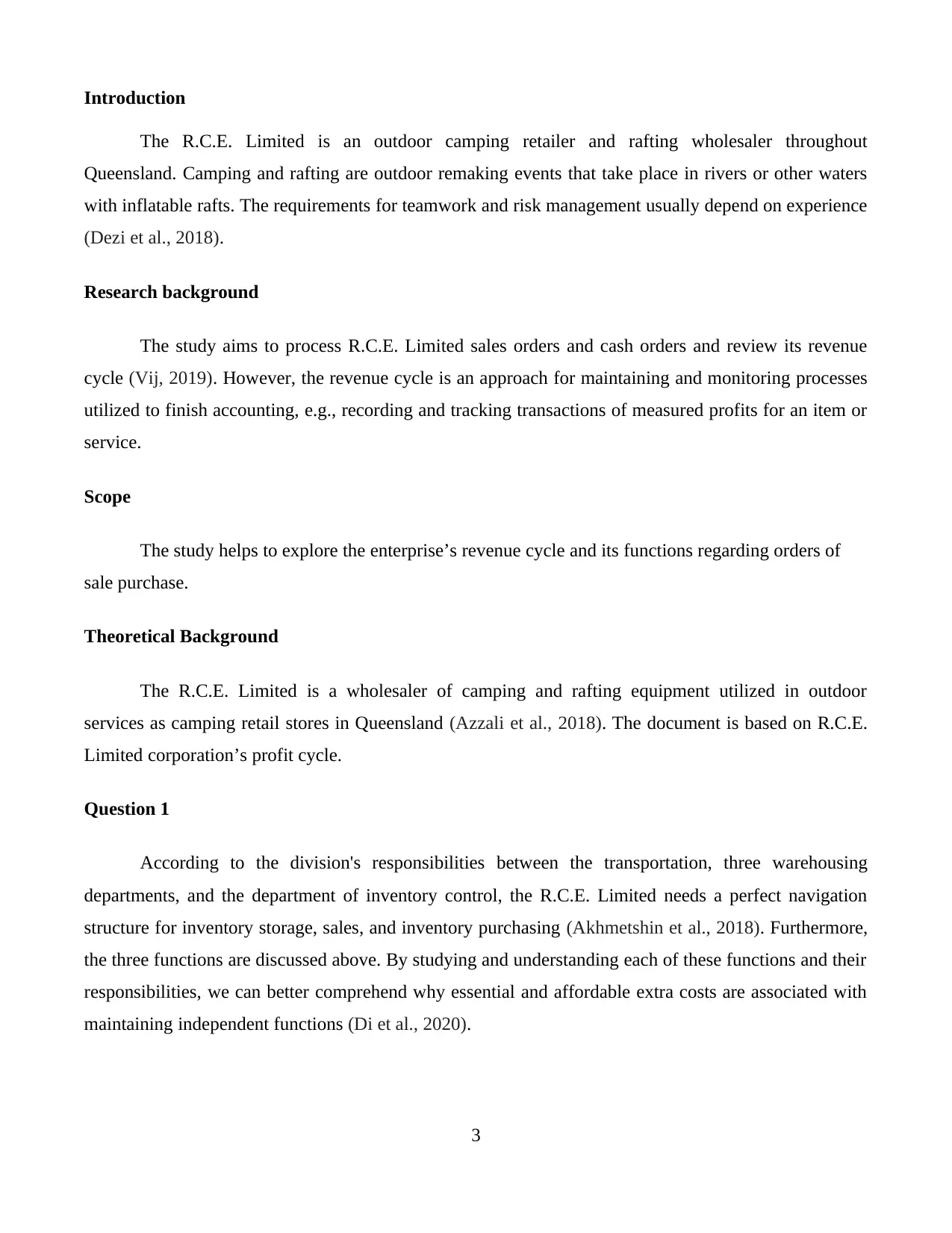
Introduction
The R.C.E. Limited is an outdoor camping retailer and rafting wholesaler throughout
Queensland. Camping and rafting are outdoor remaking events that take place in rivers or other waters
with inflatable rafts. The requirements for teamwork and risk management usually depend on experience
(Dezi et al., 2018).
Research background
The study aims to process R.C.E. Limited sales orders and cash orders and review its revenue
cycle (Vij, 2019). However, the revenue cycle is an approach for maintaining and monitoring processes
utilized to finish accounting, e.g., recording and tracking transactions of measured profits for an item or
service.
Scope
The study helps to explore the enterprise’s revenue cycle and its functions regarding orders of
sale purchase.
Theoretical Background
The R.C.E. Limited is a wholesaler of camping and rafting equipment utilized in outdoor
services as camping retail stores in Queensland (Azzali et al., 2018). The document is based on R.C.E.
Limited corporation’s profit cycle.
Question 1
According to the division's responsibilities between the transportation, three warehousing
departments, and the department of inventory control, the R.C.E. Limited needs a perfect navigation
structure for inventory storage, sales, and inventory purchasing (Akhmetshin et al., 2018). Furthermore,
the three functions are discussed above. By studying and understanding each of these functions and their
responsibilities, we can better comprehend why essential and affordable extra costs are associated with
maintaining independent functions (Di et al., 2020).
3
The R.C.E. Limited is an outdoor camping retailer and rafting wholesaler throughout
Queensland. Camping and rafting are outdoor remaking events that take place in rivers or other waters
with inflatable rafts. The requirements for teamwork and risk management usually depend on experience
(Dezi et al., 2018).
Research background
The study aims to process R.C.E. Limited sales orders and cash orders and review its revenue
cycle (Vij, 2019). However, the revenue cycle is an approach for maintaining and monitoring processes
utilized to finish accounting, e.g., recording and tracking transactions of measured profits for an item or
service.
Scope
The study helps to explore the enterprise’s revenue cycle and its functions regarding orders of
sale purchase.
Theoretical Background
The R.C.E. Limited is a wholesaler of camping and rafting equipment utilized in outdoor
services as camping retail stores in Queensland (Azzali et al., 2018). The document is based on R.C.E.
Limited corporation’s profit cycle.
Question 1
According to the division's responsibilities between the transportation, three warehousing
departments, and the department of inventory control, the R.C.E. Limited needs a perfect navigation
structure for inventory storage, sales, and inventory purchasing (Akhmetshin et al., 2018). Furthermore,
the three functions are discussed above. By studying and understanding each of these functions and their
responsibilities, we can better comprehend why essential and affordable extra costs are associated with
maintaining independent functions (Di et al., 2020).
3
⊘ This is a preview!⊘
Do you want full access?
Subscribe today to unlock all pages.

Trusted by 1+ million students worldwide
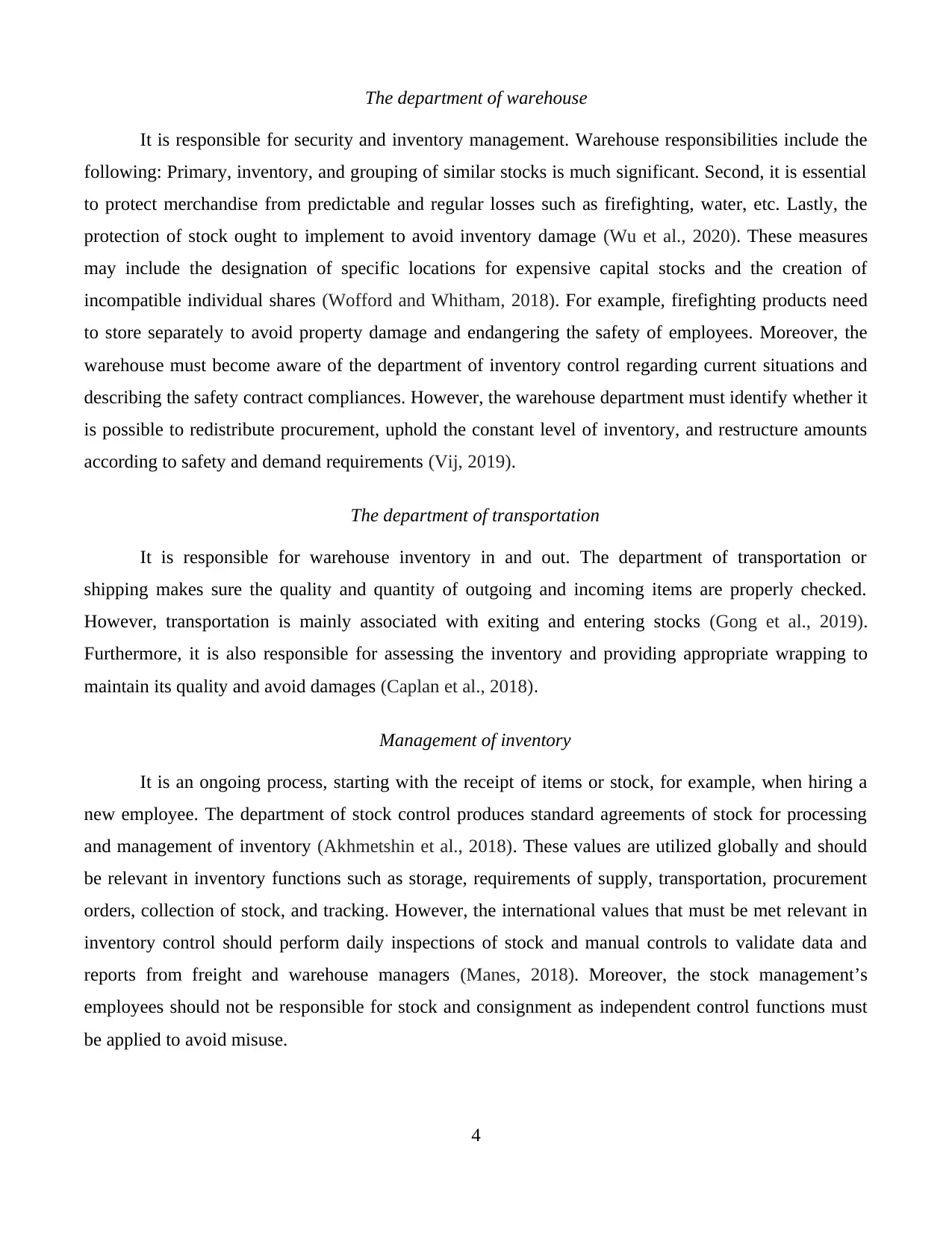
The department of warehouse
It is responsible for security and inventory management. Warehouse responsibilities include the
following: Primary, inventory, and grouping of similar stocks is much significant. Second, it is essential
to protect merchandise from predictable and regular losses such as firefighting, water, etc. Lastly, the
protection of stock ought to implement to avoid inventory damage (Wu et al., 2020). These measures
may include the designation of specific locations for expensive capital stocks and the creation of
incompatible individual shares (Wofford and Whitham, 2018). For example, firefighting products need
to store separately to avoid property damage and endangering the safety of employees. Moreover, the
warehouse must become aware of the department of inventory control regarding current situations and
describing the safety contract compliances. However, the warehouse department must identify whether it
is possible to redistribute procurement, uphold the constant level of inventory, and restructure amounts
according to safety and demand requirements (Vij, 2019).
The department of transportation
It is responsible for warehouse inventory in and out. The department of transportation or
shipping makes sure the quality and quantity of outgoing and incoming items are properly checked.
However, transportation is mainly associated with exiting and entering stocks (Gong et al., 2019).
Furthermore, it is also responsible for assessing the inventory and providing appropriate wrapping to
maintain its quality and avoid damages (Caplan et al., 2018).
Management of inventory
It is an ongoing process, starting with the receipt of items or stock, for example, when hiring a
new employee. The department of stock control produces standard agreements of stock for processing
and management of inventory (Akhmetshin et al., 2018). These values are utilized globally and should
be relevant in inventory functions such as storage, requirements of supply, transportation, procurement
orders, collection of stock, and tracking. However, the international values that must be met relevant in
inventory control should perform daily inspections of stock and manual controls to validate data and
reports from freight and warehouse managers (Manes, 2018). Moreover, the stock management’s
employees should not be responsible for stock and consignment as independent control functions must
be applied to avoid misuse.
4
It is responsible for security and inventory management. Warehouse responsibilities include the
following: Primary, inventory, and grouping of similar stocks is much significant. Second, it is essential
to protect merchandise from predictable and regular losses such as firefighting, water, etc. Lastly, the
protection of stock ought to implement to avoid inventory damage (Wu et al., 2020). These measures
may include the designation of specific locations for expensive capital stocks and the creation of
incompatible individual shares (Wofford and Whitham, 2018). For example, firefighting products need
to store separately to avoid property damage and endangering the safety of employees. Moreover, the
warehouse must become aware of the department of inventory control regarding current situations and
describing the safety contract compliances. However, the warehouse department must identify whether it
is possible to redistribute procurement, uphold the constant level of inventory, and restructure amounts
according to safety and demand requirements (Vij, 2019).
The department of transportation
It is responsible for warehouse inventory in and out. The department of transportation or
shipping makes sure the quality and quantity of outgoing and incoming items are properly checked.
However, transportation is mainly associated with exiting and entering stocks (Gong et al., 2019).
Furthermore, it is also responsible for assessing the inventory and providing appropriate wrapping to
maintain its quality and avoid damages (Caplan et al., 2018).
Management of inventory
It is an ongoing process, starting with the receipt of items or stock, for example, when hiring a
new employee. The department of stock control produces standard agreements of stock for processing
and management of inventory (Akhmetshin et al., 2018). These values are utilized globally and should
be relevant in inventory functions such as storage, requirements of supply, transportation, procurement
orders, collection of stock, and tracking. However, the international values that must be met relevant in
inventory control should perform daily inspections of stock and manual controls to validate data and
reports from freight and warehouse managers (Manes, 2018). Moreover, the stock management’s
employees should not be responsible for stock and consignment as independent control functions must
be applied to avoid misuse.
4
Paraphrase This Document
Need a fresh take? Get an instant paraphrase of this document with our AI Paraphraser
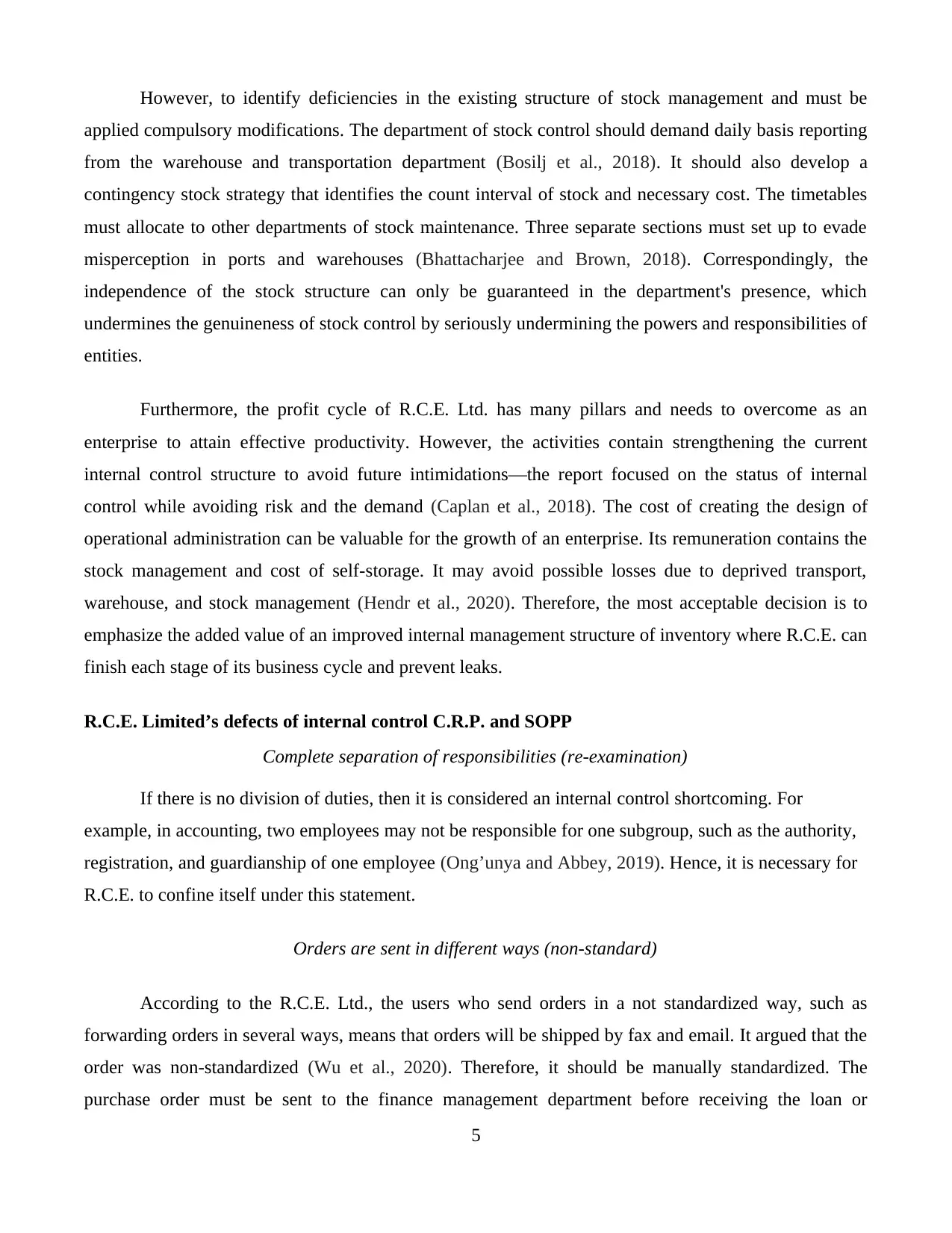
However, to identify deficiencies in the existing structure of stock management and must be
applied compulsory modifications. The department of stock control should demand daily basis reporting
from the warehouse and transportation department (Bosilj et al., 2018). It should also develop a
contingency stock strategy that identifies the count interval of stock and necessary cost. The timetables
must allocate to other departments of stock maintenance. Three separate sections must set up to evade
misperception in ports and warehouses (Bhattacharjee and Brown, 2018). Correspondingly, the
independence of the stock structure can only be guaranteed in the department's presence, which
undermines the genuineness of stock control by seriously undermining the powers and responsibilities of
entities.
Furthermore, the profit cycle of R.C.E. Ltd. has many pillars and needs to overcome as an
enterprise to attain effective productivity. However, the activities contain strengthening the current
internal control structure to avoid future intimidations—the report focused on the status of internal
control while avoiding risk and the demand (Caplan et al., 2018). The cost of creating the design of
operational administration can be valuable for the growth of an enterprise. Its remuneration contains the
stock management and cost of self-storage. It may avoid possible losses due to deprived transport,
warehouse, and stock management (Hendr et al., 2020). Therefore, the most acceptable decision is to
emphasize the added value of an improved internal management structure of inventory where R.C.E. can
finish each stage of its business cycle and prevent leaks.
R.C.E. Limited’s defects of internal control C.R.P. and SOPP
Complete separation of responsibilities (re-examination)
If there is no division of duties, then it is considered an internal control shortcoming. For
example, in accounting, two employees may not be responsible for one subgroup, such as the authority,
registration, and guardianship of one employee (Ong’unya and Abbey, 2019). Hence, it is necessary for
R.C.E. to confine itself under this statement.
Orders are sent in different ways (non-standard)
According to the R.C.E. Ltd., the users who send orders in a not standardized way, such as
forwarding orders in several ways, means that orders will be shipped by fax and email. It argued that the
order was non-standardized (Wu et al., 2020). Therefore, it should be manually standardized. The
purchase order must be sent to the finance management department before receiving the loan or
5
applied compulsory modifications. The department of stock control should demand daily basis reporting
from the warehouse and transportation department (Bosilj et al., 2018). It should also develop a
contingency stock strategy that identifies the count interval of stock and necessary cost. The timetables
must allocate to other departments of stock maintenance. Three separate sections must set up to evade
misperception in ports and warehouses (Bhattacharjee and Brown, 2018). Correspondingly, the
independence of the stock structure can only be guaranteed in the department's presence, which
undermines the genuineness of stock control by seriously undermining the powers and responsibilities of
entities.
Furthermore, the profit cycle of R.C.E. Ltd. has many pillars and needs to overcome as an
enterprise to attain effective productivity. However, the activities contain strengthening the current
internal control structure to avoid future intimidations—the report focused on the status of internal
control while avoiding risk and the demand (Caplan et al., 2018). The cost of creating the design of
operational administration can be valuable for the growth of an enterprise. Its remuneration contains the
stock management and cost of self-storage. It may avoid possible losses due to deprived transport,
warehouse, and stock management (Hendr et al., 2020). Therefore, the most acceptable decision is to
emphasize the added value of an improved internal management structure of inventory where R.C.E. can
finish each stage of its business cycle and prevent leaks.
R.C.E. Limited’s defects of internal control C.R.P. and SOPP
Complete separation of responsibilities (re-examination)
If there is no division of duties, then it is considered an internal control shortcoming. For
example, in accounting, two employees may not be responsible for one subgroup, such as the authority,
registration, and guardianship of one employee (Ong’unya and Abbey, 2019). Hence, it is necessary for
R.C.E. to confine itself under this statement.
Orders are sent in different ways (non-standard)
According to the R.C.E. Ltd., the users who send orders in a not standardized way, such as
forwarding orders in several ways, means that orders will be shipped by fax and email. It argued that the
order was non-standardized (Wu et al., 2020). Therefore, it should be manually standardized. The
purchase order must be sent to the finance management department before receiving the loan or
5
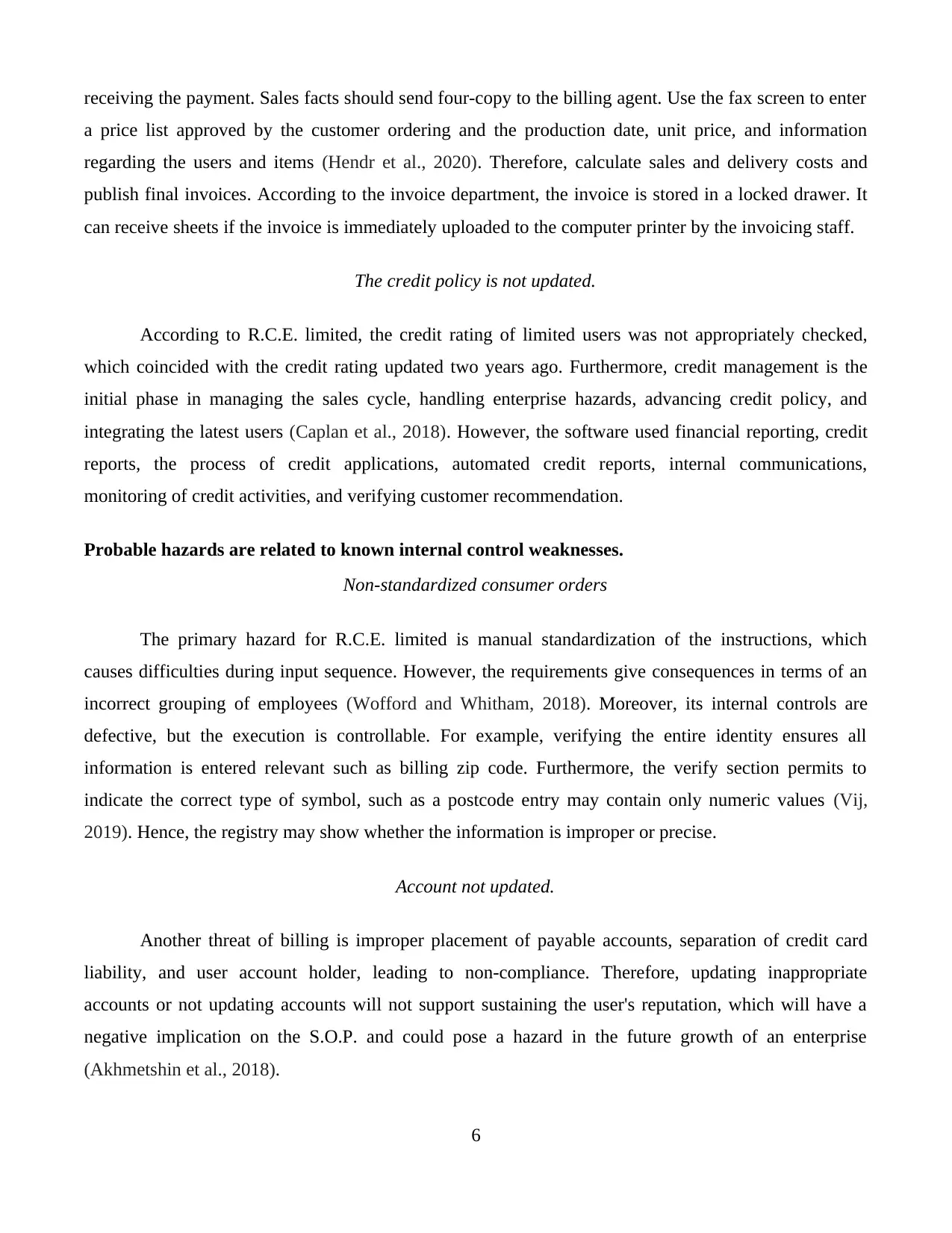
receiving the payment. Sales facts should send four-copy to the billing agent. Use the fax screen to enter
a price list approved by the customer ordering and the production date, unit price, and information
regarding the users and items (Hendr et al., 2020). Therefore, calculate sales and delivery costs and
publish final invoices. According to the invoice department, the invoice is stored in a locked drawer. It
can receive sheets if the invoice is immediately uploaded to the computer printer by the invoicing staff.
The credit policy is not updated.
According to R.C.E. limited, the credit rating of limited users was not appropriately checked,
which coincided with the credit rating updated two years ago. Furthermore, credit management is the
initial phase in managing the sales cycle, handling enterprise hazards, advancing credit policy, and
integrating the latest users (Caplan et al., 2018). However, the software used financial reporting, credit
reports, the process of credit applications, automated credit reports, internal communications,
monitoring of credit activities, and verifying customer recommendation.
Probable hazards are related to known internal control weaknesses.
Non-standardized consumer orders
The primary hazard for R.C.E. limited is manual standardization of the instructions, which
causes difficulties during input sequence. However, the requirements give consequences in terms of an
incorrect grouping of employees (Wofford and Whitham, 2018). Moreover, its internal controls are
defective, but the execution is controllable. For example, verifying the entire identity ensures all
information is entered relevant such as billing zip code. Furthermore, the verify section permits to
indicate the correct type of symbol, such as a postcode entry may contain only numeric values (Vij,
2019). Hence, the registry may show whether the information is improper or precise.
Account not updated.
Another threat of billing is improper placement of payable accounts, separation of credit card
liability, and user account holder, leading to non-compliance. Therefore, updating inappropriate
accounts or not updating accounts will not support sustaining the user's reputation, which will have a
negative implication on the S.O.P. and could pose a hazard in the future growth of an enterprise
(Akhmetshin et al., 2018).
6
a price list approved by the customer ordering and the production date, unit price, and information
regarding the users and items (Hendr et al., 2020). Therefore, calculate sales and delivery costs and
publish final invoices. According to the invoice department, the invoice is stored in a locked drawer. It
can receive sheets if the invoice is immediately uploaded to the computer printer by the invoicing staff.
The credit policy is not updated.
According to R.C.E. limited, the credit rating of limited users was not appropriately checked,
which coincided with the credit rating updated two years ago. Furthermore, credit management is the
initial phase in managing the sales cycle, handling enterprise hazards, advancing credit policy, and
integrating the latest users (Caplan et al., 2018). However, the software used financial reporting, credit
reports, the process of credit applications, automated credit reports, internal communications,
monitoring of credit activities, and verifying customer recommendation.
Probable hazards are related to known internal control weaknesses.
Non-standardized consumer orders
The primary hazard for R.C.E. limited is manual standardization of the instructions, which
causes difficulties during input sequence. However, the requirements give consequences in terms of an
incorrect grouping of employees (Wofford and Whitham, 2018). Moreover, its internal controls are
defective, but the execution is controllable. For example, verifying the entire identity ensures all
information is entered relevant such as billing zip code. Furthermore, the verify section permits to
indicate the correct type of symbol, such as a postcode entry may contain only numeric values (Vij,
2019). Hence, the registry may show whether the information is improper or precise.
Account not updated.
Another threat of billing is improper placement of payable accounts, separation of credit card
liability, and user account holder, leading to non-compliance. Therefore, updating inappropriate
accounts or not updating accounts will not support sustaining the user's reputation, which will have a
negative implication on the S.O.P. and could pose a hazard in the future growth of an enterprise
(Akhmetshin et al., 2018).
6
⊘ This is a preview!⊘
Do you want full access?
Subscribe today to unlock all pages.

Trusted by 1+ million students worldwide
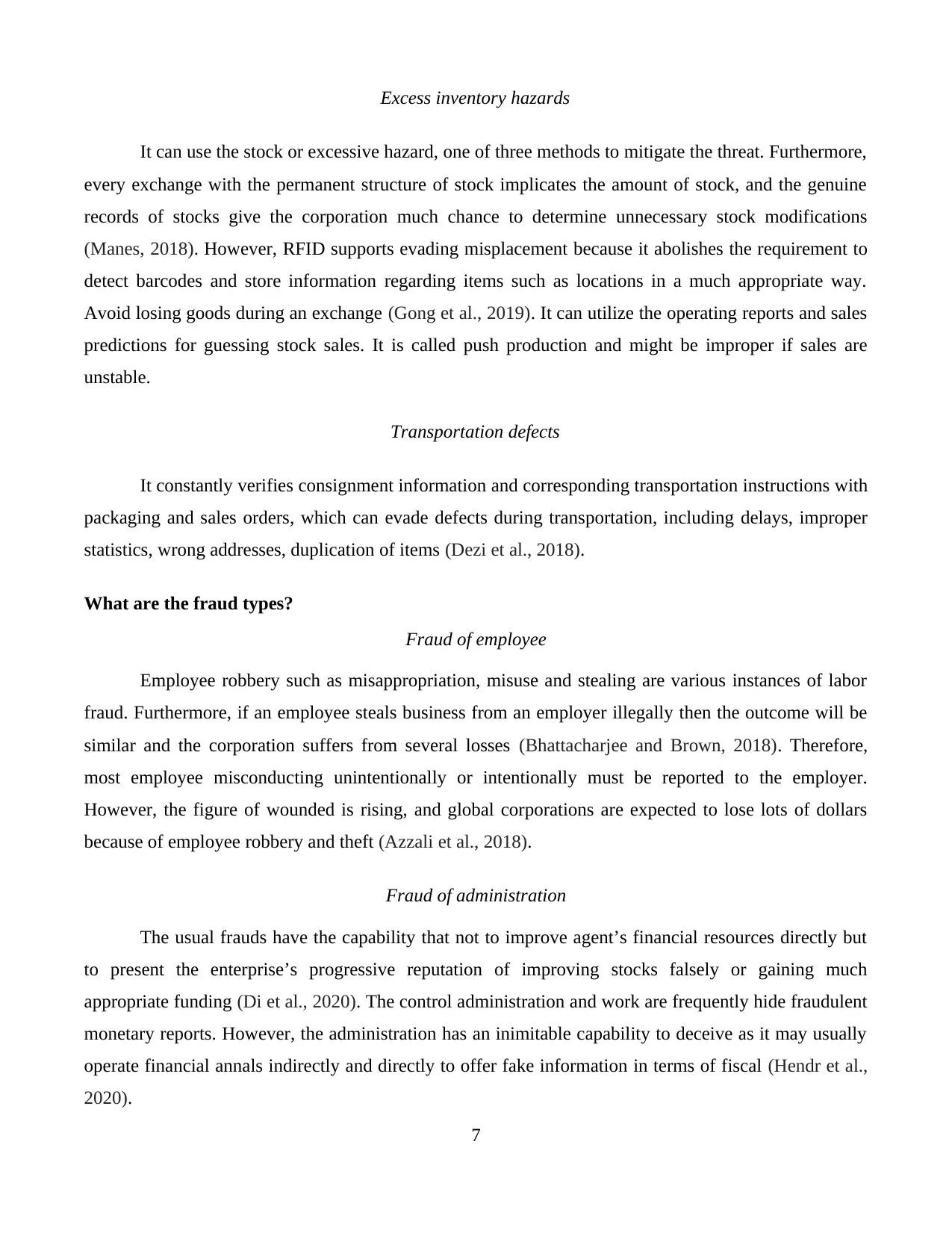
Excess inventory hazards
It can use the stock or excessive hazard, one of three methods to mitigate the threat. Furthermore,
every exchange with the permanent structure of stock implicates the amount of stock, and the genuine
records of stocks give the corporation much chance to determine unnecessary stock modifications
(Manes, 2018). However, RFID supports evading misplacement because it abolishes the requirement to
detect barcodes and store information regarding items such as locations in a much appropriate way.
Avoid losing goods during an exchange (Gong et al., 2019). It can utilize the operating reports and sales
predictions for guessing stock sales. It is called push production and might be improper if sales are
unstable.
Transportation defects
It constantly verifies consignment information and corresponding transportation instructions with
packaging and sales orders, which can evade defects during transportation, including delays, improper
statistics, wrong addresses, duplication of items (Dezi et al., 2018).
What are the fraud types?
Fraud of employee
Employee robbery such as misappropriation, misuse and stealing are various instances of labor
fraud. Furthermore, if an employee steals business from an employer illegally then the outcome will be
similar and the corporation suffers from several losses (Bhattacharjee and Brown, 2018). Therefore,
most employee misconducting unintentionally or intentionally must be reported to the employer.
However, the figure of wounded is rising, and global corporations are expected to lose lots of dollars
because of employee robbery and theft (Azzali et al., 2018).
Fraud of administration
The usual frauds have the capability that not to improve agent’s financial resources directly but
to present the enterprise’s progressive reputation of improving stocks falsely or gaining much
appropriate funding (Di et al., 2020). The control administration and work are frequently hide fraudulent
monetary reports. However, the administration has an inimitable capability to deceive as it may usually
operate financial annals indirectly and directly to offer fake information in terms of fiscal (Hendr et al.,
2020).
7
It can use the stock or excessive hazard, one of three methods to mitigate the threat. Furthermore,
every exchange with the permanent structure of stock implicates the amount of stock, and the genuine
records of stocks give the corporation much chance to determine unnecessary stock modifications
(Manes, 2018). However, RFID supports evading misplacement because it abolishes the requirement to
detect barcodes and store information regarding items such as locations in a much appropriate way.
Avoid losing goods during an exchange (Gong et al., 2019). It can utilize the operating reports and sales
predictions for guessing stock sales. It is called push production and might be improper if sales are
unstable.
Transportation defects
It constantly verifies consignment information and corresponding transportation instructions with
packaging and sales orders, which can evade defects during transportation, including delays, improper
statistics, wrong addresses, duplication of items (Dezi et al., 2018).
What are the fraud types?
Fraud of employee
Employee robbery such as misappropriation, misuse and stealing are various instances of labor
fraud. Furthermore, if an employee steals business from an employer illegally then the outcome will be
similar and the corporation suffers from several losses (Bhattacharjee and Brown, 2018). Therefore,
most employee misconducting unintentionally or intentionally must be reported to the employer.
However, the figure of wounded is rising, and global corporations are expected to lose lots of dollars
because of employee robbery and theft (Azzali et al., 2018).
Fraud of administration
The usual frauds have the capability that not to improve agent’s financial resources directly but
to present the enterprise’s progressive reputation of improving stocks falsely or gaining much
appropriate funding (Di et al., 2020). The control administration and work are frequently hide fraudulent
monetary reports. However, the administration has an inimitable capability to deceive as it may usually
operate financial annals indirectly and directly to offer fake information in terms of fiscal (Hendr et al.,
2020).
7
Paraphrase This Document
Need a fresh take? Get an instant paraphrase of this document with our AI Paraphraser
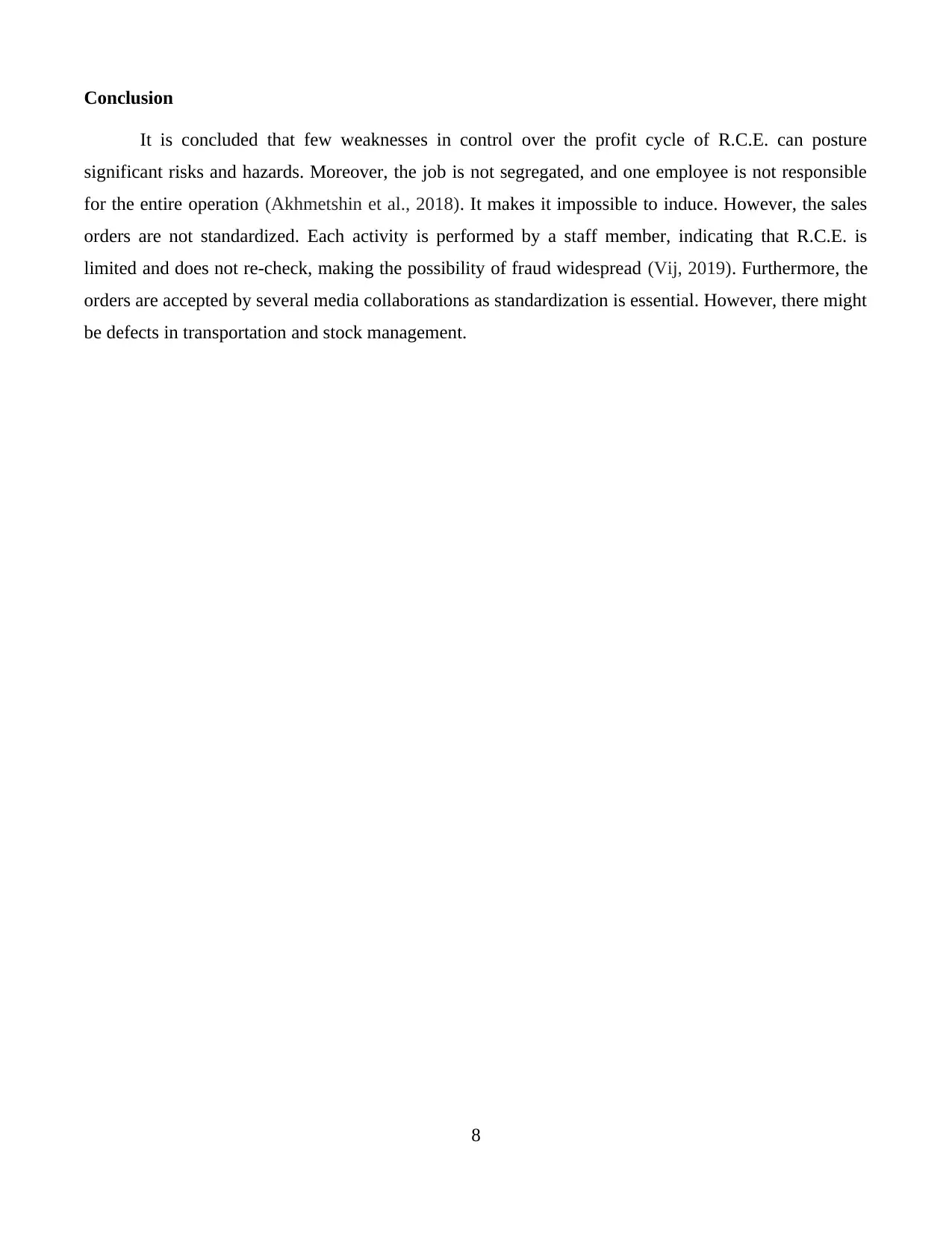
Conclusion
It is concluded that few weaknesses in control over the profit cycle of R.C.E. can posture
significant risks and hazards. Moreover, the job is not segregated, and one employee is not responsible
for the entire operation (Akhmetshin et al., 2018). It makes it impossible to induce. However, the sales
orders are not standardized. Each activity is performed by a staff member, indicating that R.C.E. is
limited and does not re-check, making the possibility of fraud widespread (Vij, 2019). Furthermore, the
orders are accepted by several media collaborations as standardization is essential. However, there might
be defects in transportation and stock management.
8
It is concluded that few weaknesses in control over the profit cycle of R.C.E. can posture
significant risks and hazards. Moreover, the job is not segregated, and one employee is not responsible
for the entire operation (Akhmetshin et al., 2018). It makes it impossible to induce. However, the sales
orders are not standardized. Each activity is performed by a staff member, indicating that R.C.E. is
limited and does not re-check, making the possibility of fraud widespread (Vij, 2019). Furthermore, the
orders are accepted by several media collaborations as standardization is essential. However, there might
be defects in transportation and stock management.
8
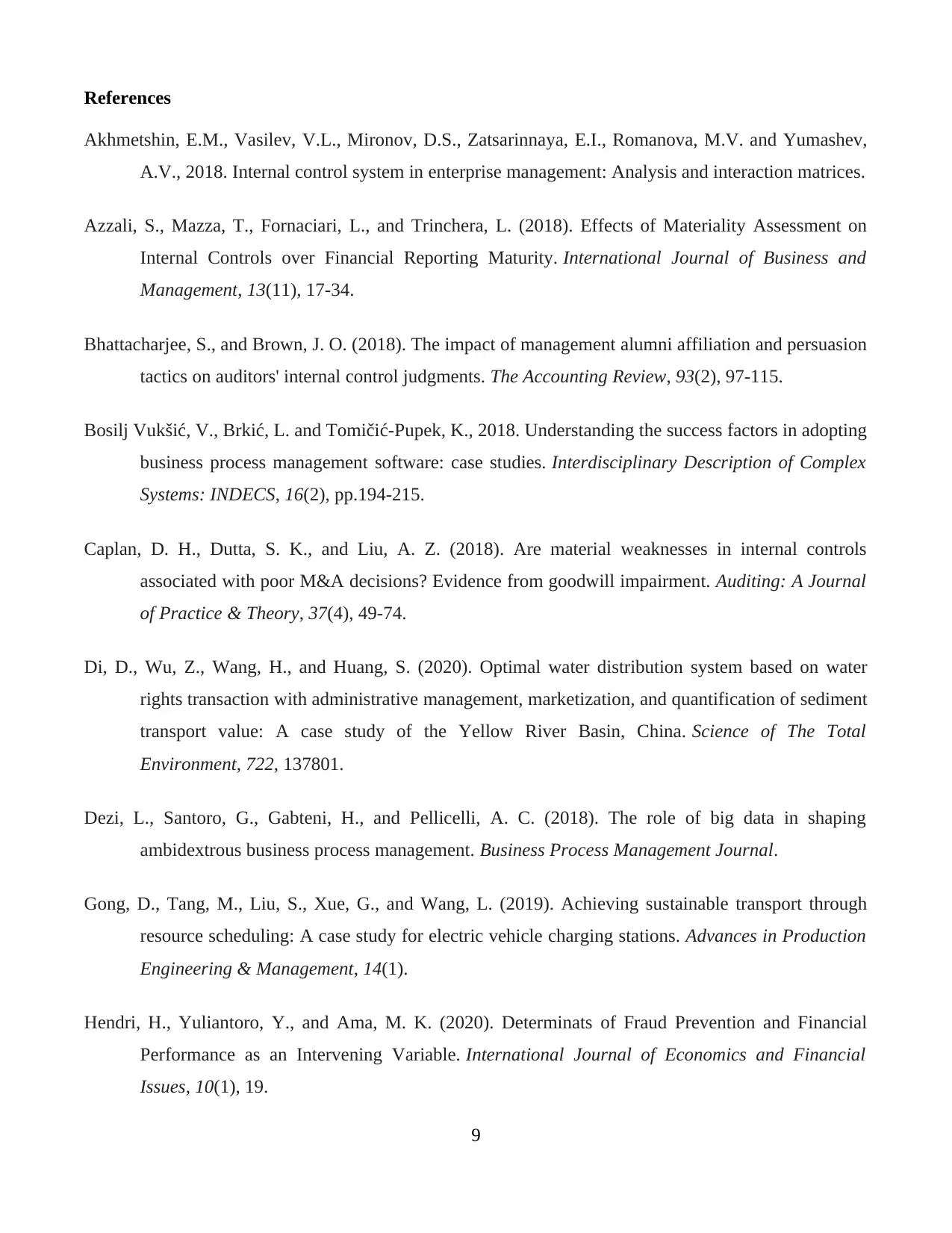
References
Akhmetshin, E.M., Vasilev, V.L., Mironov, D.S., Zatsarinnaya, Е.I., Romanova, M.V. and Yumashev,
A.V., 2018. Internal control system in enterprise management: Analysis and interaction matrices.
Azzali, S., Mazza, T., Fornaciari, L., and Trinchera, L. (2018). Effects of Materiality Assessment on
Internal Controls over Financial Reporting Maturity. International Journal of Business and
Management, 13(11), 17-34.
Bhattacharjee, S., and Brown, J. O. (2018). The impact of management alumni affiliation and persuasion
tactics on auditors' internal control judgments. The Accounting Review, 93(2), 97-115.
Bosilj Vukšić, V., Brkić, L. and Tomičić-Pupek, K., 2018. Understanding the success factors in adopting
business process management software: case studies. Interdisciplinary Description of Complex
Systems: INDECS, 16(2), pp.194-215.
Caplan, D. H., Dutta, S. K., and Liu, A. Z. (2018). Are material weaknesses in internal controls
associated with poor M&A decisions? Evidence from goodwill impairment. Auditing: A Journal
of Practice & Theory, 37(4), 49-74.
Di, D., Wu, Z., Wang, H., and Huang, S. (2020). Optimal water distribution system based on water
rights transaction with administrative management, marketization, and quantification of sediment
transport value: A case study of the Yellow River Basin, China. Science of The Total
Environment, 722, 137801.
Dezi, L., Santoro, G., Gabteni, H., and Pellicelli, A. C. (2018). The role of big data in shaping
ambidextrous business process management. Business Process Management Journal.
Gong, D., Tang, M., Liu, S., Xue, G., and Wang, L. (2019). Achieving sustainable transport through
resource scheduling: A case study for electric vehicle charging stations. Advances in Production
Engineering & Management, 14(1).
Hendri, H., Yuliantoro, Y., and Ama, M. K. (2020). Determinats of Fraud Prevention and Financial
Performance as an Intervening Variable. International Journal of Economics and Financial
Issues, 10(1), 19.
9
Akhmetshin, E.M., Vasilev, V.L., Mironov, D.S., Zatsarinnaya, Е.I., Romanova, M.V. and Yumashev,
A.V., 2018. Internal control system in enterprise management: Analysis and interaction matrices.
Azzali, S., Mazza, T., Fornaciari, L., and Trinchera, L. (2018). Effects of Materiality Assessment on
Internal Controls over Financial Reporting Maturity. International Journal of Business and
Management, 13(11), 17-34.
Bhattacharjee, S., and Brown, J. O. (2018). The impact of management alumni affiliation and persuasion
tactics on auditors' internal control judgments. The Accounting Review, 93(2), 97-115.
Bosilj Vukšić, V., Brkić, L. and Tomičić-Pupek, K., 2018. Understanding the success factors in adopting
business process management software: case studies. Interdisciplinary Description of Complex
Systems: INDECS, 16(2), pp.194-215.
Caplan, D. H., Dutta, S. K., and Liu, A. Z. (2018). Are material weaknesses in internal controls
associated with poor M&A decisions? Evidence from goodwill impairment. Auditing: A Journal
of Practice & Theory, 37(4), 49-74.
Di, D., Wu, Z., Wang, H., and Huang, S. (2020). Optimal water distribution system based on water
rights transaction with administrative management, marketization, and quantification of sediment
transport value: A case study of the Yellow River Basin, China. Science of The Total
Environment, 722, 137801.
Dezi, L., Santoro, G., Gabteni, H., and Pellicelli, A. C. (2018). The role of big data in shaping
ambidextrous business process management. Business Process Management Journal.
Gong, D., Tang, M., Liu, S., Xue, G., and Wang, L. (2019). Achieving sustainable transport through
resource scheduling: A case study for electric vehicle charging stations. Advances in Production
Engineering & Management, 14(1).
Hendri, H., Yuliantoro, Y., and Ama, M. K. (2020). Determinats of Fraud Prevention and Financial
Performance as an Intervening Variable. International Journal of Economics and Financial
Issues, 10(1), 19.
9
⊘ This is a preview!⊘
Do you want full access?
Subscribe today to unlock all pages.

Trusted by 1+ million students worldwide
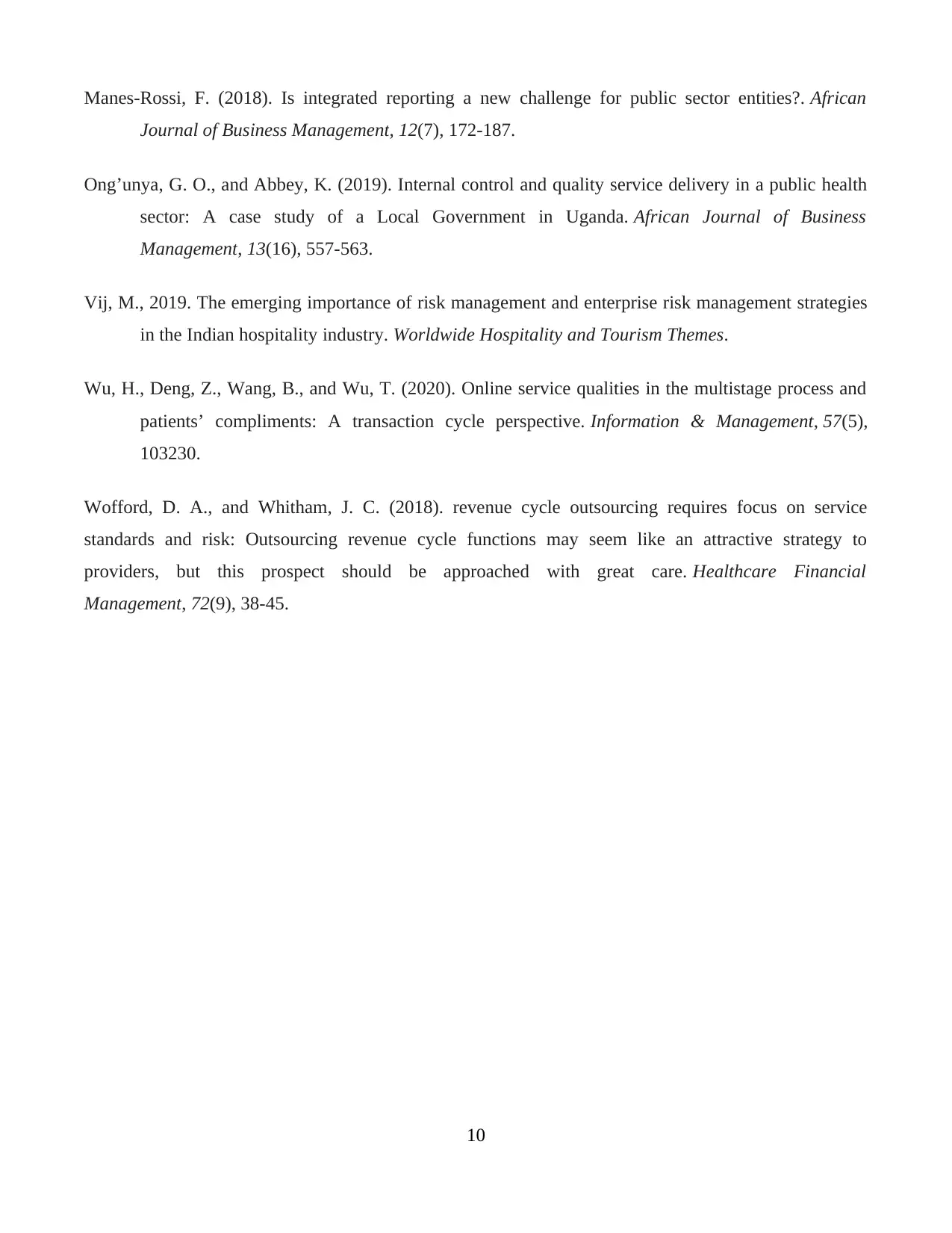
Manes-Rossi, F. (2018). Is integrated reporting a new challenge for public sector entities?. African
Journal of Business Management, 12(7), 172-187.
Ong’unya, G. O., and Abbey, K. (2019). Internal control and quality service delivery in a public health
sector: A case study of a Local Government in Uganda. African Journal of Business
Management, 13(16), 557-563.
Vij, M., 2019. The emerging importance of risk management and enterprise risk management strategies
in the Indian hospitality industry. Worldwide Hospitality and Tourism Themes.
Wu, H., Deng, Z., Wang, B., and Wu, T. (2020). Online service qualities in the multistage process and
patients’ compliments: A transaction cycle perspective. Information & Management, 57(5),
103230.
Wofford, D. A., and Whitham, J. C. (2018). revenue cycle outsourcing requires focus on service
standards and risk: Outsourcing revenue cycle functions may seem like an attractive strategy to
providers, but this prospect should be approached with great care. Healthcare Financial
Management, 72(9), 38-45.
10
Journal of Business Management, 12(7), 172-187.
Ong’unya, G. O., and Abbey, K. (2019). Internal control and quality service delivery in a public health
sector: A case study of a Local Government in Uganda. African Journal of Business
Management, 13(16), 557-563.
Vij, M., 2019. The emerging importance of risk management and enterprise risk management strategies
in the Indian hospitality industry. Worldwide Hospitality and Tourism Themes.
Wu, H., Deng, Z., Wang, B., and Wu, T. (2020). Online service qualities in the multistage process and
patients’ compliments: A transaction cycle perspective. Information & Management, 57(5),
103230.
Wofford, D. A., and Whitham, J. C. (2018). revenue cycle outsourcing requires focus on service
standards and risk: Outsourcing revenue cycle functions may seem like an attractive strategy to
providers, but this prospect should be approached with great care. Healthcare Financial
Management, 72(9), 38-45.
10
1 out of 10
Your All-in-One AI-Powered Toolkit for Academic Success.
+13062052269
info@desklib.com
Available 24*7 on WhatsApp / Email
![[object Object]](/_next/static/media/star-bottom.7253800d.svg)
Unlock your academic potential
Copyright © 2020–2025 A2Z Services. All Rights Reserved. Developed and managed by ZUCOL.


